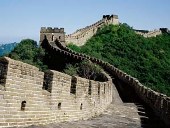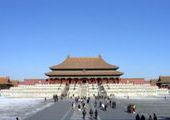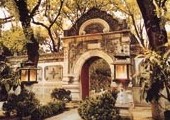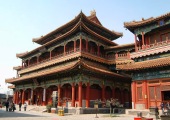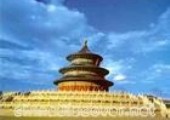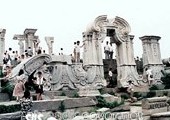Beijing Summer Palace
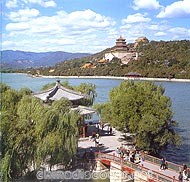
Overview
The Summer Palace, one of the finest examples garden architecture in China, is located in the northwest suburbs of Beijing. The 100-odd examples of traditional architecture in the park include pavilions, terraces, temples, pagodas, waterside gazebos, covered corridors, stone bridges and the famous marble boat. The palace occupies a total area of 290 hectares, three quarters of which is made up of shallow lakes.
Know more
The history of the Summer Palace dates back some 800 years when the first emperor of the Jin Dynasty, Wan Yanliang, moved his capital to the vicinity of Beijing and built his "God Mountain Palace" at the present site of Longevity Hill. A subsequent emperor of the same dynasty diverted the water from the nearby Jade Spring to the Gold Mountain, naming the lake it flowed into the Gold Sea. After the founding of the Yuan Dynasty, Gold Mountain was renamed Jug Mountain (Wengshan), as explained in the following legend: There was once an itinerant old man who discovered a large rock on the slope of Gold Mountain. Breaking it open, he found an earthenware jar hidden inside. The jar's surface was exquisitely carved with flowers, animals and dragons. Inside the jar were many objects of great value which the old man took away with him. Before his departure, however, he brought the jar to the sunny side of the mountain and inscribed it with the following couplet: "When this earthen jar is moved, the emperor's decline shall begin." During the Jiajing period (1522-1566) of the Ming Dynasty, the jar disappeared and, just as the old man predicted, the dynasty fell into decay.
 In 1292, Guo Shoujing, a Yuan official in charge of irrigation work, suggested digging a riverbed leading all the springs in the vicinity of Jug Mountain to facilitate grain transport. Spring water from Changping, 50 kilometers north of Beijing, was thus led to the foot of Jug Mountain, and the lake was enlarged and renamed Jug Mountain Lake.
In 1292, Guo Shoujing, a Yuan official in charge of irrigation work, suggested digging a riverbed leading all the springs in the vicinity of Jug Mountain to facilitate grain transport. Spring water from Changping, 50 kilometers north of Beijing, was thus led to the foot of Jug Mountain, and the lake was enlarged and renamed Jug Mountain Lake. The names of the lake and the park and how they have changed over the course of their long history would make a study in itself. In the Yuan Dynasty, Kunming Lake was known as the Big Lake, the West Sea or the West Lake. Visiting West Lake in April was already a popular custom among the people in this period. In the Ming Dynasty a temple was built on the south side of Longevity Hill.
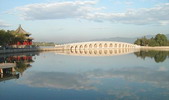 Emperor Zhengde of the Ming (reigned 1506-1521) built a palace on the bank of the lake and called it the Fine Garden for Enjoying Mountains (Haoshanyuan). He also changed Jug Mountain's name back to Gold Mountain and Jug Mountain Lake to Gold Sea. In the early 17th century, the infamous eunuch Zhongxian took over the entire garden for his private use.
Emperor Zhengde of the Ming (reigned 1506-1521) built a palace on the bank of the lake and called it the Fine Garden for Enjoying Mountains (Haoshanyuan). He also changed Jug Mountain's name back to Gold Mountain and Jug Mountain Lake to Gold Sea. In the early 17th century, the infamous eunuch Zhongxian took over the entire garden for his private use. Until the reign of Emperor Qianlong of the Qing dynasty, the Summer Palace didn't take on its present appearance until the reign of Emperor Qianlong of the Qing dynasty. He deepened the park's manmade lake and added buidings to serve as "country home" for his mother, though it would be the Empress Dowager Cixi who would have the biggest impact on the palace's appearance.
During the Second Opium War in 1860, the Summer Palace was looted and partially destroyed by French and British forces. In 1886, Cixi diverted funds earmarked to build a modern Chinese navy and spent the money on endowing the Summer Palace with a marble boat-shaped pavilion and other extravagances throughout the palace. She also gave the palace its current name, Yiheyuan, which means the "Garden for Cultivating Harmony, "an ill-fitting name as the Summer Palace would inspire little harmony.
Must see
With its handsome buildings, pretty scenery and tumultuous history, the Summer Palace is a wonderful place to explore.
Most of the major sights are concentrated in the northern part of the compound. Near the East Place Gate, the entry point for most tourists is the Hall of Benevolent Longevity, where Cixi held court on her hardwood throne. A short walk away, on the shore of Kunming Lake, is the Hall of Jade Ripples where Emperor Guangxu, Cixi's nephew, was held under house arrest on Cixi's orders for daring to undermine her authority.
The Hall for Cultivating Happiness is the name of Cixi's delightful private theater that was built for her 60th birthday, Nearby is a display that includes a Mercedes Benz, the first car imported into China. The Empress Dowager lived in the Hall of Happiness and Longevity, which is decoratedwith many perild pieces.
These private apartments open up to the most arresting construction in the Summer Palace, the Long Corridor. More than 700m long and edingat the Marble Boat, this shaded walway is decorated with some 10,000 painted scenes, each one different. Paths lead off from the Long Corridor to the temple complex atop Longvity Hill, which includes the Buddhist Incense Tower and the tiled Temple of the Sea of Wisdom. The climb will be rewarded with sweeping views of the Summer Palace and the Fragrant Hills.
The vast Summer Palace compound centers on Kumming Lake. In summer, vistors can explore the lake on boat, and skate across its frozen expanse in the Winter. The highly photogenic 17 Arch Bridge links the lake's eastern shore to South Lake Island. The most pleasurable way to escape the crowds is to take a leisurely stroll on the willow-shaded paths and arched bridges that encircle the lake bring your camera and picnic.
